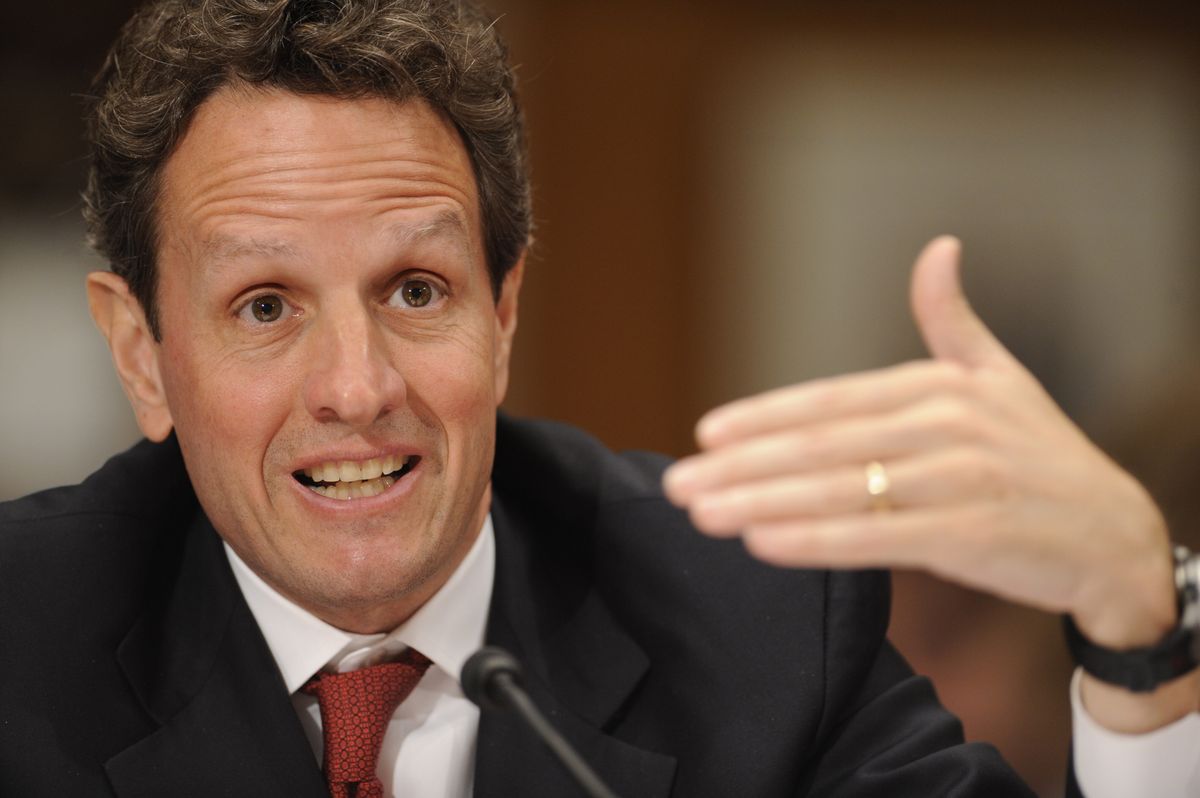Geithner says ‘majority’ of banks in good shape

WASHINGTON – Days before his agency releases key details of unusual tests to measure the health of the nation’s 19 largest banks, Treasury Secretary Timothy Geithner told a watchdog panel Tuesday that the “vast majority” have sufficient capital, implying there’s little need for more injections of taxpayer money.
Geithner resisted revealing too much about bank-rescue efforts, which are still being finalized, in the face of tough questions from the Congressional Oversight Panel, which was created to monitor the Troubled Asset Relief Program, born in last year’s $700 billion Wall Street bailout.
He acknowledged, however, that there have been “significant declines in lending for consumer loans and for commercial and industrial loans,” despite all the bailout efforts to date.
As the treasury chief testified, protesters waved pink signs behind his head that read: “Give us our $$$$$ back” and “Where’s our money?” Elizabeth Warren, the panel’s chairman and a Harvard University law professor, chose not to eject them, allowing the protest to be televised throughout the nearly two-hour hearing.
Chief among the panel’s concerns were the recently concluded stress tests, through which federal bank regulators sought to gauge whether the biggest banks have enough capital to withstand a deeper economic downturn. A report on the methodology used in the tests is expected to be made public Friday, followed by the actual results in a yet-to-be-determined form on May 4.
The banking sector as a whole gets a passing grade, Geithner signaled on Tuesday.
“Currently, the vast majority of banks have more capital than they need to be considered well-capitalized by their regulators,” even if conditions worsen, Geithner told the panel, which includes current and former lawmakers, as well as prominent public figures.
The Treasury Department is in a tough position because some banks that did well under the stress testing, including Goldman Sachs and J.P. Morgan Chase, have said so. Others, such as Bank of America, have said nothing, contributing to a 24 percent slide of the Charlotte, N.C., company’s share price on Monday.
Banks deemed to have insufficient capital have six months to raise it in the private sector or have the government step in and take an ownership stake. This may happen sooner rather than later because investors can deduce from bank chiefs’ public comments who the troubled banks are.
“Treasury is in a box on reporting,” said Scott Talbott, chief lobbyist for the Financial Services Roundtable, which represents many of the nation’s largest financial institutions. “If they release the individual (bank) results, it could threaten the safety and soundness of a bank. If they don’t release results, it would look like they were hiding something.”
As Geithner fielded questions, the special inspector general tapped to monitor TARP spending sent an alarming quarterly report to Congress. Neil Barofsky said what began as a $700 billion bank rescue effort “has evolved into a program of unprecedented scope, scale and complexity.”
The TARP has mushroomed into 12 separate programs involving taxpayer and private funds worth up to $3 trillion, much of it vulnerable to fraud.
Elaborating on an item first reported by McClatchy newspapers on Feb. 5, Barofsky said his office has initiated nearly 20 criminal investigations into possible misuse of TARP funds. These inquiries are examining potential corporate and securities fraud involving TARP money, tax violations, insider trading, public corruption and fraud involving mortgage modification programs.
Barofsky was particularly troubled with the Public-Private Investment Program, which has only been described by Treasury in the broadest of terms. Under this plan, the government would join private investors in purchasing the troubled assets that are polluting bank balance sheets since few investors want to buy them at anything but fire sale prices.
This program is “inherently vulnerable to fraud, waste and abuse,” Barofsky’s report said, calling on Treasury to impose strict conflict-of-interest rules on fund managers and require disclosure of all private investors to limit collusion and even money laundering.
The PPIP has been controversial since unveiled on March 23, because it’s designed to lure private investors to buy bank assets with a large measure of taxpayer support. For an asset worth $100 but sold for $84, the government and investor could each put up as little as $6 and the remaining $72 would be financed through a low-cost government loan.
Critics charge that taxpayers bear most of the risk if the asset loses value while sharing the reward of any gain.
“I just don’t get it, Mr. Secretary, how this represents protecting the taxpayer,” said Damon Silvers, a panel member and chief counsel for AFL-CIO.
Geithner countered that the plan must be compared to the alternative, which was having the government purchase all the troubled assets.
“You can’t measure the returns to the taxpayer through this narrow prism,” Geithner said.
He said that the alternative programs “have government taking all the risks in mispricing. … That tradeoff is a bad tradeoff for the government. Government is highly unlikely to get the evaluation right.”
Another flashpoint was how and when banks can repay the TARP money they’ve taken.
“This is a judgment that I don’t make. Regulators make them,” Geithner told panelist John Sununu, a former Republican senator from New Hampshire.
Sununu reacted with visible annoyance.
“You are going to expect and ask the regulators to make a subjective judgment about whether our national system of credit is working?” he asked.